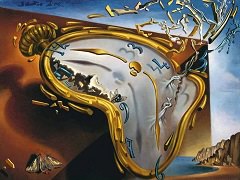Le Sommeil (Sleep), 1937 by Salvador Dali

In Le Sommeil (Sleep), Dali recreated the kind of large, soft head and virtually non-existent body that had featured so often in his paintings around 1929. In this case, however, the face is certainly not a self-portrait. Sleep and dreams are par excellence in the realm of the unconscious, and consequently of special interest to psychoanalysts and Surrealists. Crutches had always been a Dali trademark, hinting at the fragility of the supports which maintain 'reality', but here nothing seems inherently stable, and even the dog needs to be propped up! Everything in the picture except the head is bathed in a pale bluish light, completing the sense of alienation from the world of daylight and rationality.
In Le Sommeil Salvador Dali returned to a classic Surrealist motif that was probably inspired by his inclusion in the exhibition of Surreal 'objects' at the Galerie Charles Ratton, in which the public was invited to "touch their dreams". Dreams are, of course, the essence of much Freudian theory because of their access into the unconscious, a preoccupation theme for the Surrealists, including Dali.
Freudian theories, however, extends beyond just a consideration of the unconscious. In Beyond the Pleasure Principle by Freud, the renowned psychologist proposed a theory, Thanatos, or 'Death Instinct', in which he suggests that all animals, including humans, try to prolong their life by defending all threats of death that are inappropriate to their particular species. In humans, this is manifest as aggression if the threat is external and self-destruction when directed at the self. The counterpart to Thanatos is Eros in which an individual life moves towards a 'natural' death. Le Sommeil seems to suggest that tension, the head in a catatonic state supported by a series of crutches.























